Beyond the Limits of the Art Museum: Interview with Tomoko Konoike
Tomoko Konoike: Flip at Artizon Museum through October 25, 2020 was Konoike’s first major show in Tokyo in 11 years. Its displays included: Fusuma-e, which featured a cross-section of the earth, flowing water, tornadoes, stones, and a slide; a new installation made up of giant sliding door paintings; the 12×4-meter work “Leather Black Kite” with several pieces of cowhide forming its base; and the “Shadow picture lantern” installation using the interplay of light and shadow. All of these works shared space with pieces by artists including Camille Corot, Gustave Courbet, and Alfred Sisley.
To produce her art, Konoike draws on the various workings of the world––the words and deeds of people she encounters during travels, the sun, or sometimes typhoons, plants, insects, and bacteria. To see her works on site is to experience the meaning of these words.
Tomoko Konoike: Flip was the first exhibition in Jam Session, a series based on Artizon Museum’s concept of “experiencing creation.” To be held once a year, these shows involve artists and curators working together to create new art inspired by works selected from the Ishibashi Foundation Collection. These exhibits bringing about new perspective are like “jam sessions” between the collection and works by participating artists. Tokyo Art Beat (TAB) interviewed Konoike about her exhibition for this project that intends to act as a bridge between the past, present, and future.
Resonating with the Collection
TAB: One of the main tenets of Jam Session is that the artist chooses collection works meant to resonate with her own. However, as explained in the exhibition text, you did not select the collection works, curator Kyoko Kagawa did. How did you feel seeing the pieces by Courbet, Corot, and others along with your works?
Konoike: Like it says in the text, I came three times to select works from the collection and after that I spent time poring over the collection list, but I just couldn’t choose. I didn’t understand why at the time, but now I realize that bringing collection works into the exhibition gave me the sense of creating relationships and critiques in an art system with a narrowly defined postmodern perspective. It differentiated between the modern and the contemporary in a way that doesn’t exist any more. And even if I didn’t view it that way, I was afraid that visitors would, and I thought I needed to be careful to create a structure avoiding that.
When I saw the lineup of works in the space, I didn’t feel such a distinction of “my works are here, the collection works are over there.” The collection is a focus, and while I was aware of being a guest artist, at the same time, I saw the collection as a natural extension of my own works.
TAB: Do you mean the collection lost its authority and you saw all of the works from the same vantage point?
Konoike: Yes. It sounds strange, doesn’t it, when you’ve got works by someone else mixed in? It’s not that everything is completely level, but I now look at things from the same perspective, whether they’re people, objects, or landscapes. Even with my own works, when they’re installed in a space in the future, they’ll be arranged as a set and captioned with a title and “Tomoko Konoike” listed as the artist. It’s all turned into data, which maybe seems only natural, but to me is very strange. At the very least, to me an art exhibition isn’t about displaying works to be interpreted in linguistic, temporal, or educational ways. Maybe this is putting it roughly, but I think it’s about giving the works in their entirety to the people alive at that time to use as they see fit. Whether the works are classical or contemporary, created by different people, or made of pre-existing objects, it’s important for the people living at the time to get a proper sense of the exhibition as a space.
Thinking about things this way, it doesn’t matter to me or the viewer whether the works are from the collection or not. With this exhibition, I wanted viewers, regardless of background, to encounter the artworks with no preconceptions. I wanted to create a space they could physically experience in all its interest or lack thereof.
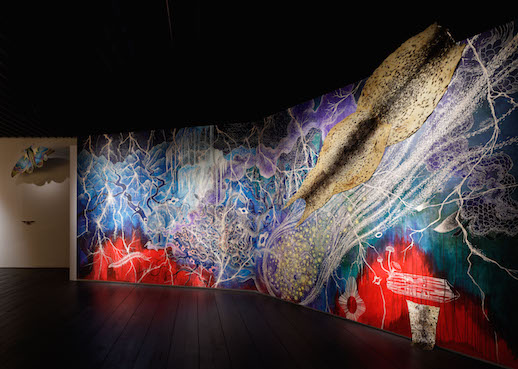
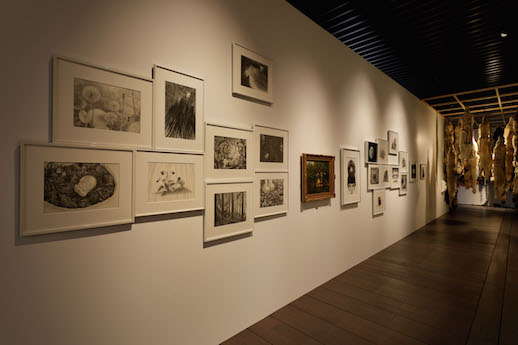
Overcoming the Shortcomings of the Art Museum
TAB: You thoroughly research the places where you display your works and the circumstances surrounding them, bringing out these features in your works. What sort of preparations did you make for this show?
Konoike: Bridgestone Museum of Art reopened as the new Artizon Museum, and it was explained to me that my show would be its first contemporary art exhibition. At the time I was having a solo show in Akita Prefecture, and in the corner of my mind I had an image of Bridgestone tires turning as we talked. What would creativity mean to this museum? To explore that I visited Kurume, Fukuoka Prefecture, where Bridgestone Corporation originated. I learned about the founder Shojiro Ishibashi and the history of tire development. It was interesting to discover that the history and development of Bridgestone neatly overlaps with the historical background of Japan’s modernization.
TAB: And what did you think of Artizon Museum as a place? The exhibition text includes a 2018 conversation between you and Professor Mayako Murai in which you state that the work of exhibitions is to make the place rather than the artist the main subject. You say, “I go to [the museum] and use all my senses to get a feeling for the place.” What were your perceptions of Artizon Museum?
Konoike: Artizon Museum was still under construction when I visited for the first time, and I scouted it out while there were still lots of people working on it. There are three floors of exhibition space, and the visitor moves through them from top to bottom rather than vice versa. I envisioned visitors drawing energy from below, winding their way down the space. That image has a lot of overlap with my tornado works.
I believe that originally, the exhibition space was meant to be a place where the artist displays her own works in an assigned space, constructing her worldview around a specific theme while visitors come to encounter it. But I think the visitor is always busy with thoughts about external factors, like what route to take through the exhibition, what can be seen out the window, what kind of smells there are, what the weather outside is like, etc. No one really knows how a visitor’s imagination plays out, but even when I’m making artworks or models, I’m always thinking about the movements of the visitor as a kind of animal. I don’t know how the works themselves will influence him, but I believe they will have a big effect.
For this exhibition, I’d like everyone to focus on the framework and “skeletons” of the show. For example, for the ramp of “Fusuma-e,” I spoke with builders and chose the simplest, least customized approach so that anyone could understand the structure.
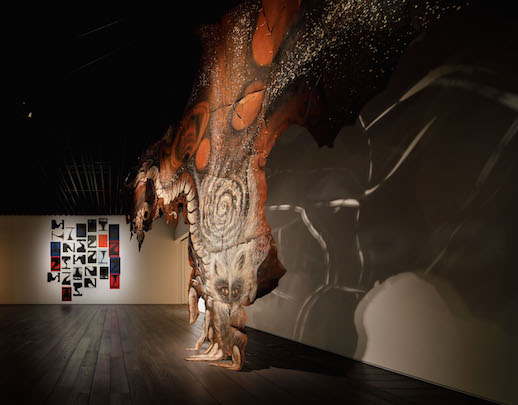
TAB: It has kind of a rough quality to it, doesn’t it?
Konoike: I want to show things honestly. If I used techniques to make just the surface of works refined, the prettiness of them would dilute their energy from the start. For example, with “Leather Black Kite,” I colored on premade cowhide with crayon, opened holes, and increased the size by sewing thread through with drawstring. The motor on the pendulum installation is also a simple device, and technique-wise the installation “Shadow picture lantern” could be done by anyone. I consulted with all the technical staff and craftspeople and had them stop at the point where anyone could recreate the technology, so that the works would not lose any of their energy.
TAB: Didn’t you want to add things at some point?
Konoike: The ability to create visual illusions and be fascinated with the process is limited to people with sight. Everyone, including me, perceives the world through a different body. Thinking about that, rather than things being too simple and uninteresting, it seems like conversely, through simple materials, forms, structures, and gravitational relationships, we understand how we exist here together. You don’t have to study difficult subjects to experience the joy of living. I think that’s what I want to express.
TAB: Do you think you enhanced the rough and wild parts of the exhibition in response to Artizon Museum being such a new, refined place?
Konoike: If we’re talking about the difference between exhibiting the works in an art museum or outdoors, I don’t see much of a difference at this point. One thing I can say, however, is that the safety and protection of an art museum is its greatest weakness. The air is kept a certain way, the lighting is just so, microbes are shut out, and artworks are protected as treasures in safe, perfect, closed-off rooms. When designing my exhibition, I thought about how this weakness could be overcome. Art museums are built to expel foreign matter, but I think I’ve brought some in. Through my works, I want to show how these elements can exist within the art museum.
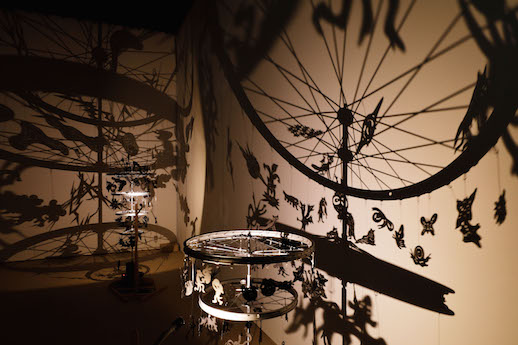
TAB: Actually, while I was experiencing the enormous energy of the works, I happened to notice a guard wiping down the railing of the ramp in “Fusuma-e,” disinfecting it. That scene––with the wildness and fierce energy of the art in competition with the clean, quiet, sacred space of the art museum––gave me goose bumps. What you just said reminded me of that.
Konoike: Yes. For example, I made my “Leather Black Kite” for the 2019 Setouchi Triennale. For close to a year it was displayed in the beautiful forest of Oshima, where there is a national Hansen’s Disease sanatorium, exposed to nature. Before the current exhibition started it was taken out of the forest, packed up, completely fumigated, and had all the micro-organisms, spider webs, and dust cleared away. I wasn’t really sure about the circumstances or necessity of this, but I had no choice but to agree. The work needed to be exhibited. This strange conflict made me realize that overcoming the weaknesses of the art museum is an action necessary for people today.
Tomorrow we’ll have other things to do, and we have to survive while responding to changing climates and conditions. But, taking the opposite direction of this living and evolving, there are some museums built with a human desire to enclose moments in eternity. I’ve come to think that in order to give museums resources for thinking about things like the energy of the earth and surrounding environments, we need to create “shortcuts” to the outside.
TAB: “Shortcuts.” That phrase strikes a chord with me. When you put it like that, the “Fusuma-e” installation’s ramp seems like kind of a “shortcut.”
Konoike: With “Fusuma-e,” you climb up the ramp to view the paintings and have an experience like your body is gradually getting bigger. Then, at the end, you whoosh down the slide. Like I mentioned earlier, it’s like you forget your fascination with the exhibition’s illusions, have gravity flipped on you, and go head over heels. The exhibition title “Flip” refers to that sensation.
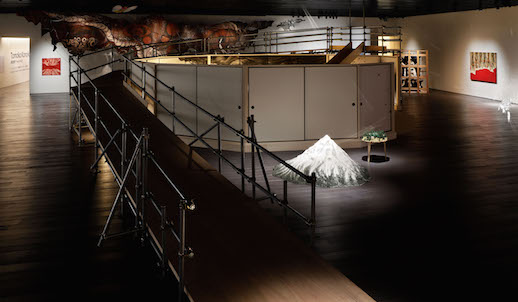
Settling Things Through Art
TAB: This exhibition had its dates changed due to the pandemic, and currently many people are thinking about the coronavirus on a daily basis. I find in this situation I often recall my state of mind after the Great East Japan Earthquake. You’ve said in previous interviews that since that disaster you’ve felt the need to change your style of creating artworks. How do you feel about the current situation?
Konoike: This is not easy to say, but now is a fortunate time to be someone who creates. You can spend time thinking things through, reflecting on survival, and people are getting their own ideas rather than rehashing or overlapping with those of others. We’re in a moment when we’re forced to think independently rather than through other people. These days are hard, but I also feel that little by little they’re coming to be filled with a deep joy. In that sense, I think we’re lucky.
TAB: In these unprecedented times we have to think of all kinds of matters as affecting us directly. It requires a lot of effort, but at the same time, there is a lot of joy, isn’t there?
Konoike: I think that this is because even as people suffer, our survival means that within each of us is there is a way of breathing called art. I feel my role is to offer viewers various ways of breathing. That’s about the extent to which I feel I can help. Then, if visitors take what they have felt and seen back home with them and use it for their daily lives and work, I feel satisfied.
Until now art has only posed questions. To myself too, every day I asked, “Why?” and “How?” Now for once I want to stop simply posing questions to society and being persuaded by its messages. I want to put things in practice rather than in words and try to settle things through the work that I call my art. Even if things don’t go well after they’re resolved, I’ll do them over. I want to engage in this form of “play.”
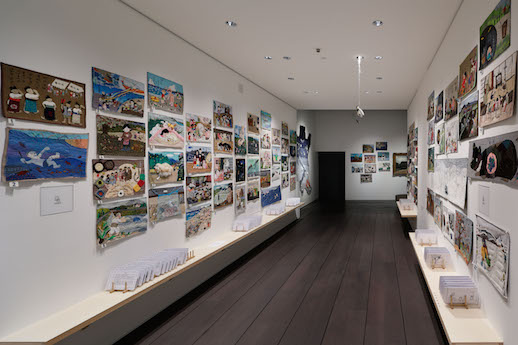
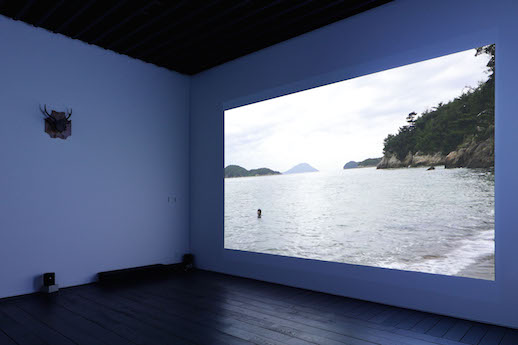
About Tomoko Konoike
Born in Akita Prefecture in 1960. Held the solo show “Primordial Violence” at Kanagawa Kenmin Hall in 2015. Received the Minister of Education Award for Fine Arts in 2016. Other solo exhibitions include “Fur Story” at Leeds Art University (England) and “Hunter Gatherer” at Akita Museum of Modern Art in 2018. Group exhibitions include “Temporal Turn” at Spencer Museum of Art/KU Biodiversity Institute & Natural History Museum (USA) in 2016 and the Setouchi Triennale in 2019.
This interview has been translated from Japanese.



